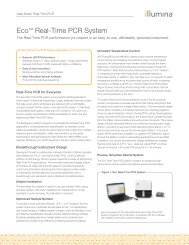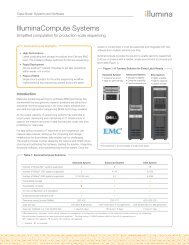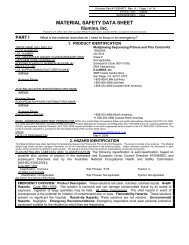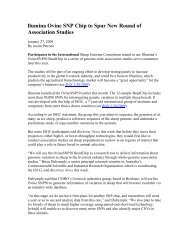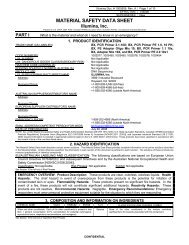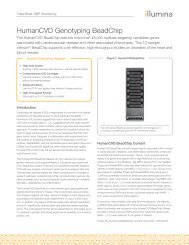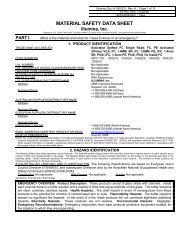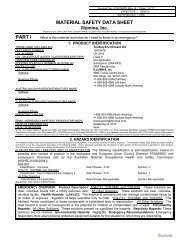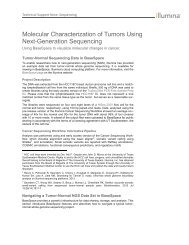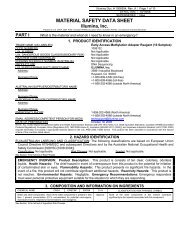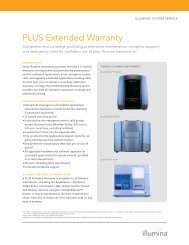MATERIAL SAFETY DATA SHEET - Illumina
MATERIAL SAFETY DATA SHEET - Illumina
MATERIAL SAFETY DATA SHEET - Illumina
Create successful ePaper yourself
Turn your PDF publications into a flip-book with our unique Google optimized e-Paper software.
Infinium II Assay System Reagents <strong>Illumina</strong> Doc. # 11195131, Rev. H Page 20 of 27<br />
11. TOXICOLOGICAL INFORMATION (Continued)<br />
TOXICITY <strong>DATA</strong> (continued):<br />
SODIUM SALT (continued):<br />
Mutation Test Systems-Not Otherwise Specified<br />
(Oral-Rat) 400 mg/kg<br />
Unscheduled DNA Synthesis (Oral-Rat) 16,800<br />
mg/kg/4 weeks-continuous<br />
Cytogenetic Analysis (Intraperitoneal-Rat) 2338<br />
mg/kg<br />
Cytogenetic Analysis (Hamster Ovary) 160 mmol/L<br />
Cytogenetic Analysis (Hamster Lung) 7500 mg/L<br />
Mutation in Microorganisms (Yeast-Saccharomyces<br />
cerevisiae) 2 mol/L<br />
DNA Damage (Bacteria-Salmonella typhimurium) 10<br />
gm/L/120 minutes<br />
DNA Damage (Mouse Lymphocyte) 101 mmol/L<br />
DNA Damage (Hamster Ovary) 275 mmol/L<br />
Mutation in Mammalian Somatic Cells (Mouse<br />
Lymphocyte) 57,200 µmol/L<br />
Mutation in Mammalian Somatic Cells (Mouse Cells-<br />
Not Otherwise Specified) 5000 mg/L/4 hours<br />
DNA Repair (Bacteria-Salmonella typhimurium) 10<br />
gm/L/120 minutes<br />
Micronucleus Test (Hamster-Lung) 4 gm/L<br />
Micronucleus Test (Oral-Rat) 2 pph/14 days<br />
Micronucleus Test (Mouse Cells-Not Otherwise<br />
Specified) 0.5 pph/4 hours<br />
CARBOHYDRATE:<br />
LD50 (oral, rat) = 29,700 mg/kg; Behavioral:<br />
somnolence (general depressed activity); Lungs,<br />
Thorax, or Respiration: cyanosis; Gastrointestinal:<br />
hypermotility, diarrhea<br />
LD50 (intraperitoneal, mouse) = 14,000 mg/kg<br />
LDLo (oral, mammal) = 40 g/kg; Behavioral:<br />
somnolence (general depressed activity); Lungs,<br />
Thorax, or Respiration: respiratory stimulation;<br />
Gastrointestinal: hypermotility, diarrhea<br />
CARBOHYDRATE (continued):<br />
TDLo (oral, rat) = 1548 g/kg/female 21 days premating/female<br />
1–22 days after conception;<br />
Reproductive: Specific Developmental<br />
Abnormalities: Central Nervous System<br />
TDLo (oral, rat) = 683 g/kg/female 1–21 days after<br />
conception; Reproductive: Specific Developmental<br />
Abnormalities: hepatobiliary system; Reproductive:<br />
Effects on Newborn: growth statistics (e.g.%,<br />
reduced weight gain)<br />
TDLo (oral, rat) = 683 g/kg/lactating female 21 days<br />
post-birth; Reproductive: Effects on Newborn:<br />
growth statistics (e.g.%, reduced weight gain)<br />
TDLo (oral, mammal) = 54,810 mg/kg/female 15–35<br />
days after conception; Reproductive: Effects on<br />
Embryo or Fetus: fetotoxicity (except death, e.g.,<br />
stunted fetus)<br />
Mutation in Microorganisms (bacteria, Salmonella<br />
typhimurium) = 600 μg/plate<br />
DNA Repair (yeast, Saccharomyces cerevisiae) = 300<br />
mg/L<br />
Cytogenetic Analysis (lung, hamster) = 10 g/L<br />
Cytogenetic Analysis (ovary, hamster) = 275 mmol/L<br />
ALKANOLAMINE:<br />
Standard Draize Test (Skin-Rat) 100 mg<br />
Standard Draize Test (Skin-Rabbit) 25%: Moderate<br />
Standard Draize Test (Eye-Rabbit) 500 mg: Severe<br />
LD50 (Oral-Rat) > 3000 mg/kg<br />
LD50 (Oral-Mouse) 5500 mg/kg<br />
LD50 (Intravenous-Rat) 1800 mg/kg<br />
LD50 (Intravenous-Rat) 3.28 g/kg: Liver: hepatitis<br />
(hepatocellular necrosis), diffuse;<br />
Kidney/Ureter/Bladder: changes in tubules<br />
(including acute renal failure & tubular necrosis)<br />
ALKANOLAMINE (continued):<br />
LD50 (Intravenous-Mouse) 1210 mg/kg<br />
LD50 (Intravenous-Mouse) 6100 mg/kg: Behavioral:<br />
muscle weakness; Lungs, Thorax, or Respiration:<br />
respiratory depression<br />
LD50 (Intraperitoneal-Mouse) 3350 mg/kg<br />
TDLo (Oral-Rat) 12,000 mg/kg: female 14 day(s) premating:<br />
4 day(s) post-birth: Reproductive: Maternal<br />
Effects: other effects; Fertility: post-implantation<br />
mortality (e.g. dead and/or resorbed implants per<br />
total number of implants); Sense Organs and<br />
Special Senses (Ear): effect, not otherwise<br />
specified<br />
TDLo (Oral-Rat) 3000 mg/kg: Kidney/Ureter/Bladder:<br />
urine volume increased<br />
TDLo (Oral-Mouse) 3000 mg/kg:<br />
Kidney/Ureter/Bladder: urine volume increased<br />
TDLo (Intravenous-Rat) 6000 mg/kg/20 daysintermittent:<br />
Gastrointestinal: ulceration or<br />
bleeding from stomach; Kidney/Ureter/Bladder:<br />
changes in both tubules and glomeruli<br />
TDLo (Intravenous-Rabbit) 500 mg/kg: Lungs,<br />
Thorax, or Respiration: dyspnea<br />
TDLo (Intravenous-Rabbit) 10,000 mg/kg/4 weeksintermittent:<br />
Sense Organs and Special Senses<br />
(Ear): effect, not otherwise specified; Blood:<br />
changes in leukocyte (WBC) count; Biochemical:<br />
Metabolism (Intermediary): effect on inflammation<br />
or mediation of inflammation<br />
TDLo (Intravenous-Dog) 125 mg/kg: Lungs, Thorax,<br />
or Respiration: dyspnea<br />
LDLo (Oral-Mouse) 1 g/kg: Behavioral: somnolence<br />
(general depressed activity), muscle weakness,<br />
coma<br />
CARCINOGENIC POTENTIAL OF COMPONENTS: The components of this product are listed by agencies tracking<br />
the carcinogenic potential of chemical compounds, as follows:<br />
REFINED HYDROCARBON: ACGIH TLV-A4 (Not Classifiable as Human Carcinogen)<br />
CARBOHYDRATE: ACGIH TLV-A4 (Not Classifiable as Human Carcinogen)<br />
The remaining constituents in the solutions of this product are not found on the following lists: U.S. EPA, U.S.<br />
NTP, U.S. OSHA, U.S. NIOSH, GERMAN MAK, IARC, or ACGIH and therefore are neither considered to be nor<br />
suspected to be cancer causing agents by these agencies.<br />
IRRITANCY OF PRODUCT:<br />
Code WG#-RA1 and Code WG#-WB1 Components: Depending on the duration and concentration of overexposure, skin and<br />
eye contact can irritate contaminated tissue.<br />
All Other Components: Contact with the skin or eyes may cause mild irritation, which is alleviated upon rinsing.<br />
SENSITIZATION TO THE PRODUCT: The components of this product are not known to cause skin or respiratory<br />
sensitization.<br />
REPRODUCTIVE TOXICITY INFORMATION: Listed below is information concerning the effects of this product and<br />
its components on the human reproductive system.<br />
Mutagenicity: The constituents in the solutions in this product are not reported to produce mutagenic effects in humans. Human<br />
mutation data are available for the Alkyl Alcohol and Aliphatic Triol constituents in this product’s solutions; these data were<br />
obtained during clinical studies on specific human tissues exposed to high doses of these compounds. Animal mutation data<br />
are available for the Aliphatic Amide, Aliphatic Diol, and Carbohydrate constituents in this product’s solutions; these data were<br />
obtained during clinical studies on specific animal tissues exposed to high doses of this compound.<br />
Embryotoxicity: The constituents in the solutions in this product are not reported to cause human embryotoxic effects.<br />
Teratogenicity: The constituents in the solutions in this product are reported to cause teratogenic effects in humans. Clinical<br />
studies on test animals exposed to relatively high doses of the Alkyl Alcohol, Aliphatic Amide, Refined Hydrocarbon, Aliphatic<br />
Diol, and Carbohydrate constituents in this product’s solutions, indicate teratogenic effects.<br />
Reproductive Toxicity: The constituents in the solutions in this product are not reported to cause adverse reproductive effects in<br />
humans. Clinical studies on human tissues exposed to relatively high doses of the Alkyl Alcohol constituent in this product’s<br />
solutions indicate adverse reproductive effects. Clinical studies on test animals exposed to relatively high doses of the Aliphatic<br />
Amide, Aliphatic Triol, and Aliphatic Diol constituents in this product’s solutions indicate adverse reproductive effects.<br />
BIOLOGICAL EXPOSURE INDICES: Currently, there are no Biological Exposure Indices (BEIs) determined for the<br />
constituents in this product’s components.<br />
12. ECOLOGICAL INFORMATION<br />
ALL WORK PRACTICES MUST BE AIMED AT ELIMINATING ENVIRONMENTAL CONTAMINATION.<br />
MOBILITY IN SOIL: This product has not been tested for mobility in soil. The following information is available for<br />
some constituents.<br />
ALKYL ALCOHOL:<br />
Using a structure estimation method based on molecular connectivity indices, the Koc for Alkyl Alcohol can be estimated to be 1. According to a classification<br />
scheme, this estimated Koc value suggests that Alkyl Alcohol is expected to have very high mobility in soil<br />
ALIPHATIC AMIDE:<br />
The Koc of Aliphatic Amide is 3.6. According to a classification scheme, this Koc value suggests that Aliphatic Amide is expected to have very high mobility in soil.



